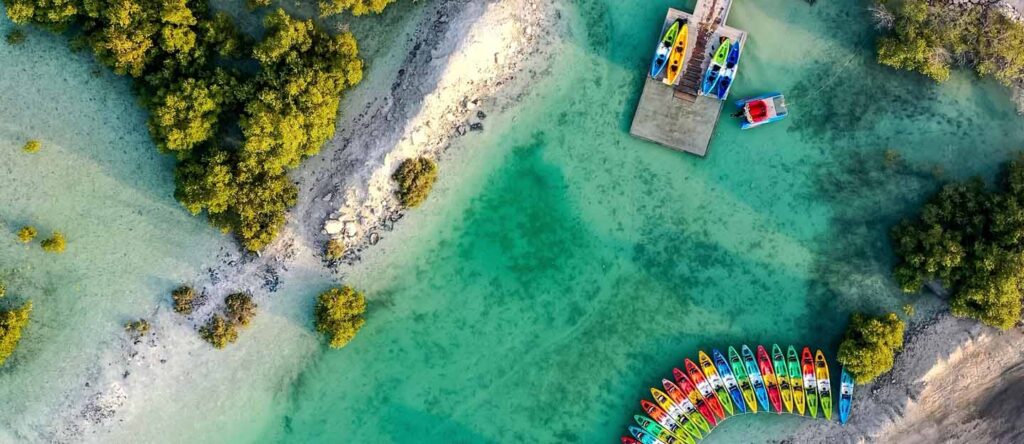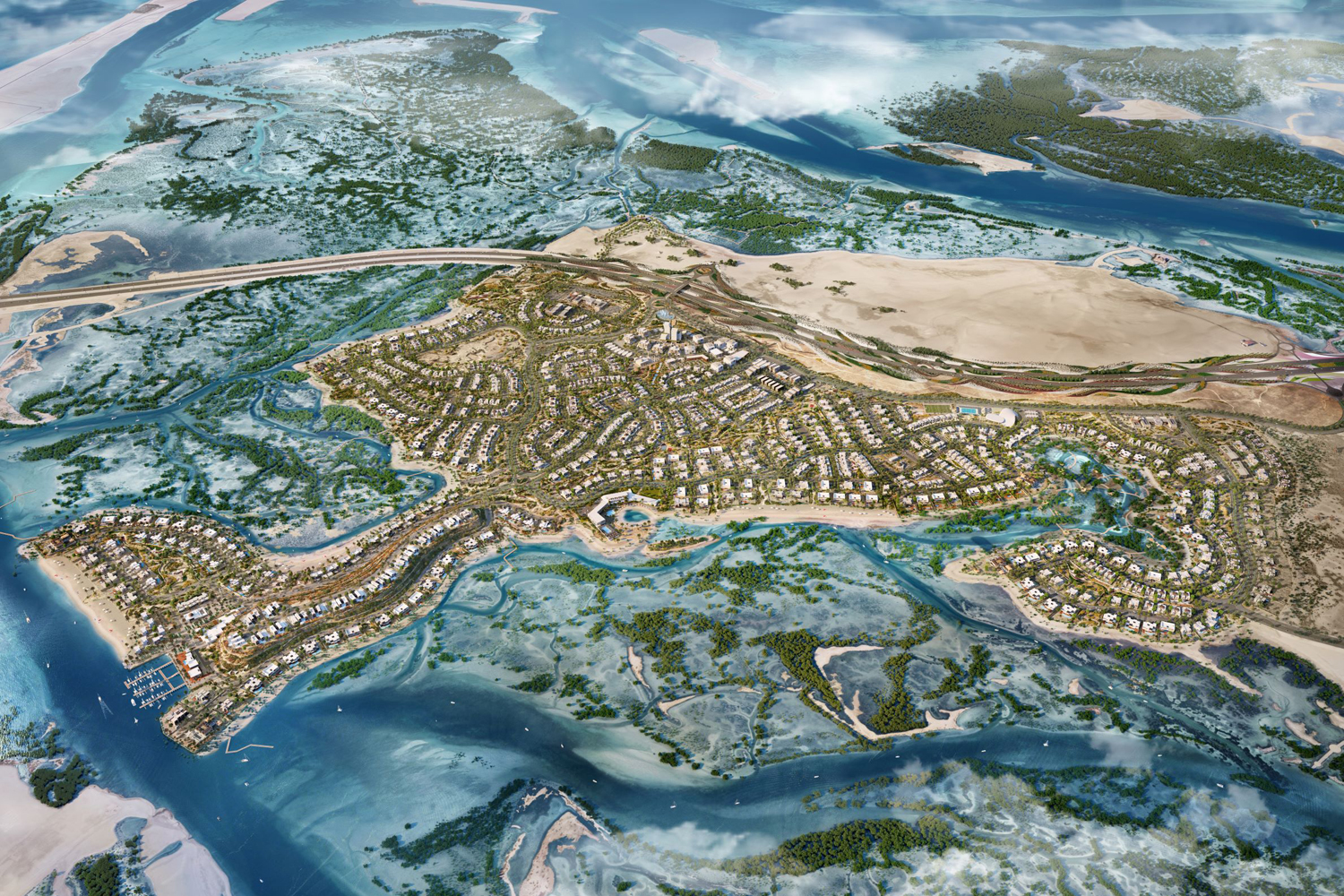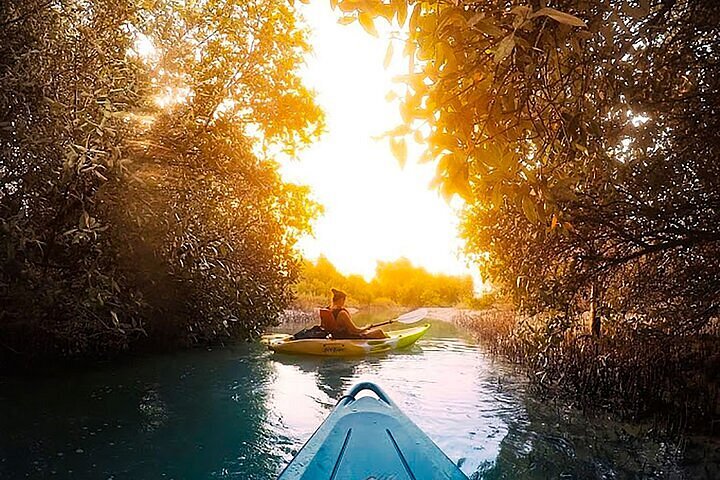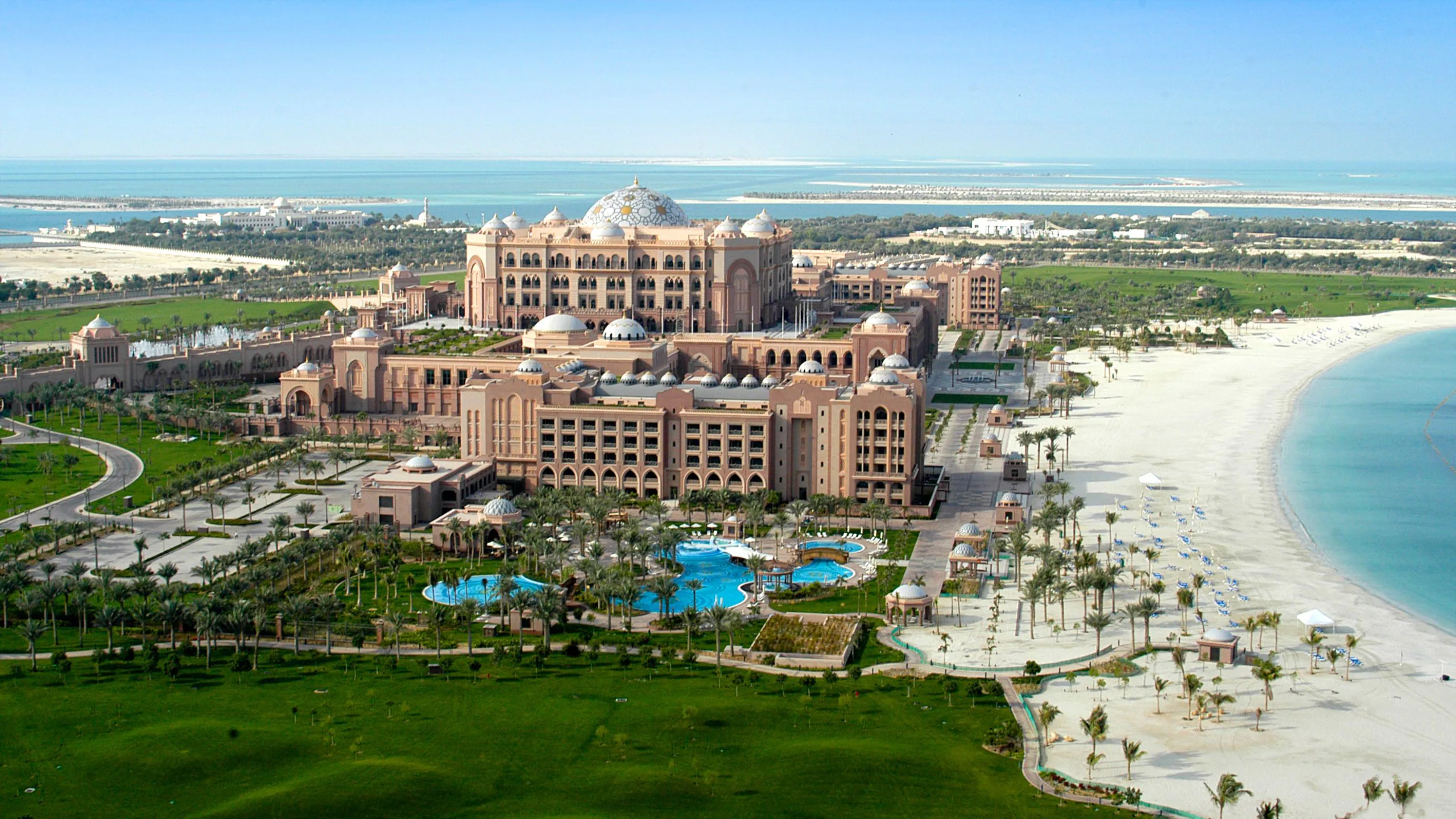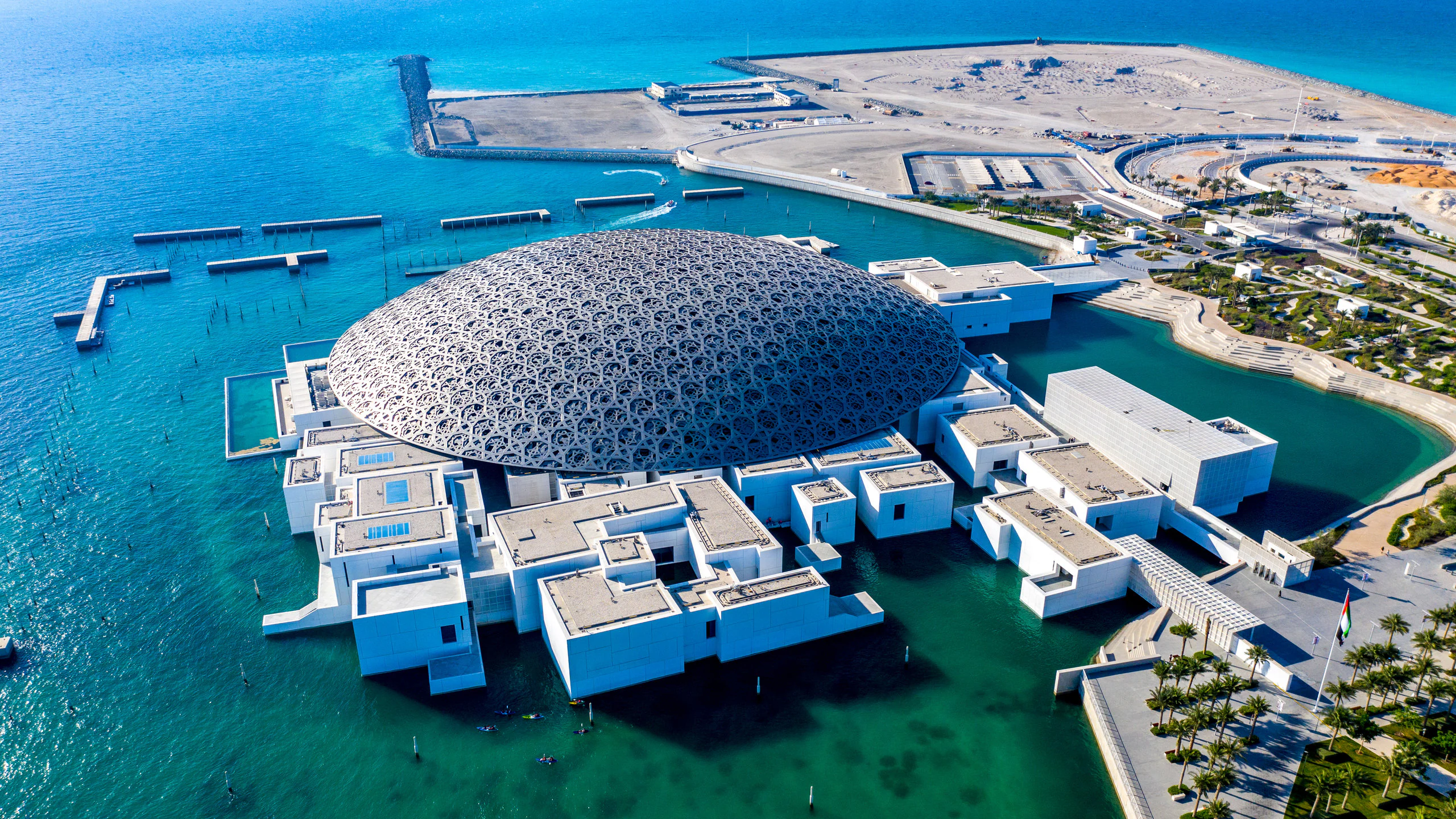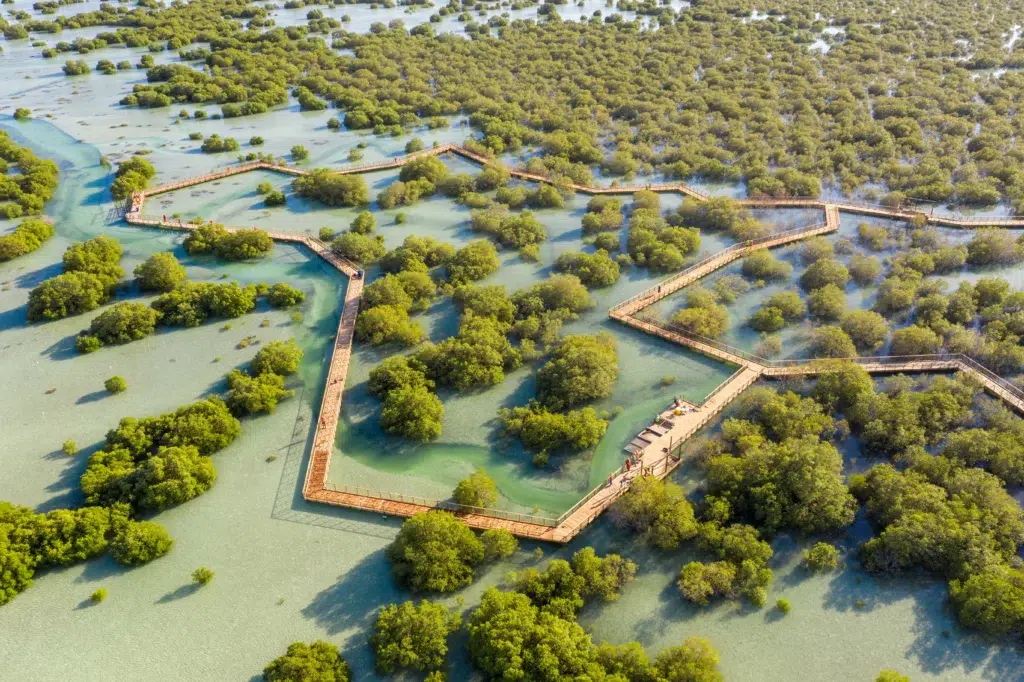Abu Dhabi — the shining capital of the United Arab Emirates — is often celebrated for its futuristic skyline, desert dunes, and luxurious landmarks. Yet, hidden amidst its calm coastline lies a breathtaking natural treasure — Jubail Mangrove Park, also known as Al Jubail Mangrove Park. This ecological gem on Al Jubail Island Abu Dhabi stands as a symbol of the nation’s ongoing efforts to restore, protect, and cherish the mangrove forests in the UAE.
Far more than just a green attraction, Jubail Mangrove Park Abu Dhabi is an inspiring intersection between nature, sustainability, and thoughtful design. It offers visitors a chance to reconnect with the environment through serene mangrove walks, kayaking tours, and educational experiences.
In this guide, we’ll explore:
- The park’s location, design, and ecological importance
- Its connection with Eastern Mangrove National Park Abu Dhabi
- Visitor information, tickets, and access details
- Key activities like kayak mangrove Abu Dhabi and the mangrove walk
- Conservation initiatives and future developments
- A complete visitor itinerary and travel tips
Let’s dive into the peaceful world of Jubail Mangrove Park — a living sanctuary within Abu Dhabi’s modern landscape.
Setting the Scene — Location, Scope, and Design
1. Location & Context
Nestled between Saadiyat Island and Yas Island, Jubail Mangrove Park sits gracefully on Al Jubail Island, a stunning ecological zone often called simply Jubail Island Abu Dhabi. The park is around a 20–30 minute drive from Abu Dhabi International Airport and equally convenient from the city center, making it ideal for locals and tourists alike.
Al Jubail Island is envisioned as a sustainable, nature-inspired community, blending eco-conscious living with conservation. At the heart of this vision lies Al Jubail Mangrove Park, where nature and innovation meet in perfect harmony.
2. Scale & Design
Covering nearly 19 square kilometers, Jubail Mangrove Park Abu Dhabi is designed to immerse visitors into a thriving wetland ecosystem without disturbing its natural balance. The park’s layout includes a network of elevated wooden boardwalks that meander through mangrove trees, salt marshes, tidal channels, and lagoon areas.
Visitors can choose from multiple trail lengths — 1 km, 1.6 km, and 2 km loops — making it easy to explore at their own pace. Along the way, learning points and rest zones provide insights into the park’s biodiversity and ecological importance.
Architecturally, the park minimizes its footprint on the environment. The elevated pathways allow visitors to walk close to the water while protecting delicate mangrove roots below. Some design studies reveal that the park shelters nearly 75% of Abu Dhabi’s total mangrove cover — a remarkable contribution to mangrove conservation in the UAE.
Ecological Importance — The Mangrove Network in Abu Dhabi
1. The Role of Mangroves in UAE
The mangroves in UAE are vital to the country’s coastal health and biodiversity. Though the UAE is largely known for its desert terrain, its coastlines host a rich mangrove ecosystem that performs several crucial roles — preventing erosion, filtering water, sequestering carbon, and supporting marine and bird life.
In Abu Dhabi, these mangroves form part of a broader network that includes the Eastern Mangrove Lagoon National Park Abu Dhabi, also known as Eastern Mangrove National Park. Together, they safeguard one of the most significant natural habitats in the Arabian Gulf.
2. Biodiversity & Ecological Functions
The mangrove ecosystem at Jubail Mangrove Park is home to an incredible diversity of flora and fauna:
- Birdlife: Herons, egrets, kingfishers, bulbuls, and plovers can be spotted along the mangrove walk Abu Dhabi.
- Marine Life: The tidal channels are alive with crabs, fish, and small invertebrates.
- Other Wildlife: Occasionally, visitors may glimpse turtles or small reptiles in quieter areas.
These mangroves also act as blue carbon sinks, absorbing carbon dioxide from the atmosphere and combating climate change. Every boardwalk and water channel tells the story of resilience — how nature thrives when given space to breathe.
3. Conservation & Research
Al Jubail Mangrove Park is not merely a sightseeing destination; it’s a model for ecological restoration. Active reforestation projects on Jubail Island aim to expand mangrove coverage, stabilize coastlines, and protect against rising sea levels.
The park also serves as an outdoor classroom, raising awareness about environmental stewardship. With continuous monitoring using satellite data and modern technologies, authorities are ensuring the sustainable growth of the mangrove forest in UAE.
Visiting Jubail Mangrove Park
1. Tickets & Pricing
Entry to Jubail Mangrove Park is affordable and well-organized:
- General entry tickets for the mangrove walk are typically around AED 15.
- Some self-guided walks may start from AED 10, depending on the season.
- Kayak mangrove Abu Dhabi experiences are separately priced — roughly AED 160 for a two-hour guided tour.
- Occasionally, combo offers are available that include both walking and kayaking.
Visitors can book Jubail Mangrove Park tickets online in advance to ensure availability. Always verify whether your ticket covers the boardwalk, kayaking, or guided experiences before purchase.
2. Opening Hours
The park is open daily from 7:00 AM to 9:00 PM, with last entry typically around 8:00 PM. However, timings may vary for special activities such as glow kayaking or evening guided tours.
3. Entry Guidelines
To ensure a safe and respectful experience, visitors are advised to:
- Pre-book entry (walk-ins are limited).
- Refrain from touching plants or feeding wildlife.
- Supervise children under 12 at all times.
- Avoid littering or carrying outside food within the mangrove area.
- Dress modestly and wear comfortable shoes.
Free parking is available onsite, and basic facilities such as restrooms and small refreshment points are provided.
4. Getting There
Reaching Jubail Mangrove Park Abu Dhabi is easy:
- A short drive from Abu Dhabi International Airport or city center.
- Accessible via Saadiyat Island or Yas Island by car or taxi.
- For visitors coming from Dubai, the trip takes about an hour, depending on traffic.
Simply follow navigation apps to Al Jubail Island, and signs will guide you directly to the Jubail Mangrove Park entrance.
Activities and Experiences at Jubail Mangrove Park
1. The Mangrove Walk / Boardwalk
The main highlight — the mangrove walk Abu Dhabi — allows you to stroll across a series of elevated wooden paths surrounded by tranquil waters and lush greenery.
The boardwalk offers three trail options (1 km, 1.6 km, and 2 km), each designed to let visitors explore mangrove habitats at varying depths and distances. Along the way, you’ll encounter educational panels, shaded viewpoints, and even a watchtower that provides a panoramic view of the mangrove canopy.
It’s an ideal spot for photography, birdwatching, or simply escaping the city buzz to immerse yourself in nature’s calm rhythm.
2. Kayaking — A Closer Look at Nature
For those seeking a more immersive experience, kayak mangrove Abu Dhabi tours are an unforgettable way to explore the park’s waterways.
Paddling through narrow tidal channels lets you witness the mangroves from water level — where light dances across roots and small fish dart beneath your kayak.
Most tours last 1.5–2 hours and are led by certified guides who share fascinating insights about the ecosystem. Special experiences like night glow kayaking add a magical twist, with illuminated kayaks gliding through the serene waters under the stars.
3. Guided Tours & Educational Programs
To deepen understanding, the park offers guided nature walks and interpretive sessions. Trained guides explain the biology of mangroves, their role in coastal protection, and the efforts behind mangrove restoration in the UAE.
Interactive “learning nodes” positioned along the walkway make it a great educational visit for families, students, and eco-tourists alike.
4. Wildlife & Photography
Every corner of Al Jubail Mangrove Park offers picture-perfect scenes:
- Herons and egrets standing elegantly on roots
- Tiny crabs burrowing in the mudflats
- Schools of fish shimmering in the shallow lagoons
Whether you’re a professional photographer or a casual visitor, the early morning and sunset hours provide the best natural light for capturing the park’s beauty.
5. Connection with Eastern Mangrove National Park
The Jubail Mangrove Park is closely connected to the larger Eastern Mangrove National Park Abu Dhabi, a vast mangrove ecosystem located near the city’s edge.
While the Mangrove National Park tickets offer broader kayaking and paddleboarding access, Jubail Mangrove Park provides a more structured, walkable experience — ideal for families and beginners.
Together, they form an interconnected network that celebrates the mangrove forests of Abu Dhabi, serving both as educational spaces and conservation zones.
Visitor’s Guide & Sample Itinerary
1. Best Times to Visit
The charm of Jubail Mangrove Park changes beautifully with the time of day, offering a different experience each time you visit.
- Morning (7:00 AM – 10:00 AM): The air is cool, wildlife is active, and the sunlight creates a soft golden glow—perfect for birdwatching and photography.
- Late Afternoon / Sunset: As the day cools, the park becomes even more peaceful. The golden-hour light reflecting off the mangrove waters offers magical photo opportunities.
- Night / Glow Tours: Some kayak mangrove Abu Dhabi operators offer illuminated night kayaking sessions. These LED-lit kayaks create a surreal atmosphere as you glide through glowing reflections.
- Best Season: From October to March, temperatures are pleasant, making this the ideal time to explore both Jubail Mangrove Park and Eastern Mangrove Lagoon National Park Abu Dhabi.
Keep in mind that water levels vary with the tides—plan your visit during mid or high tide to see the mangroves in their full splendor.
2. Tips & Preparation
A little preparation can help you make the most of your visit to Al Jubail Mangrove Park:
- Book early: Especially for weekends or guided kayak tours.
- Check tide charts: High tide offers a fuller experience for walking and kayaking.
- Dress smart: Lightweight, breathable clothing; sun hats; and comfortable shoes are a must.
- Stay protected: Use sunscreen and insect repellent.
- Pack light: Carry water, a camera, and binoculars for birdwatching.
- Respect nature: Stick to designated paths, avoid touching plants, and do not disturb wildlife.
- Safety first: Children under 12 should always be accompanied by an adult.
These small steps ensure a safe and eco-friendly adventure through Abu Dhabi’s most serene natural park.
3. Suggested Half-Day Itinerary
8:00 AM – Arrival and Orientation
Arrive at Jubail Mangrove Park Abu Dhabi, check in at the visitor center, and receive your orientation briefing.
8:15 AM – The Mangrove Walk
Begin your mangrove walk Abu Dhabi along the 2 km trail. Take your time at observation decks and learning stations, enjoying the stillness of nature and spotting birds along the boardwalk.
9:00 AM – Kayaking Experience
Join a guided kayak mangrove Abu Dhabi tour for a closer look at the roots and waterways. The calm waters make this suitable even for beginners.
10:45 AM – Relax and Refresh
After your kayak session, unwind near the visitor area, sip on a cool drink, and browse the educational displays on mangroves in UAE.
11:15 AM – Photography & Exit
Before leaving, capture panoramic shots from the viewing tower or simply enjoy one last peaceful moment surrounded by the sound of water and birds.
4. Full-Day Itinerary Option
For nature enthusiasts looking to explore further, extend your journey beyond Jubail Mangrove Park:
- Spend the morning exploring the park and its trails.
- Enjoy lunch at a nearby café on Jubail Island Abu Dhabi.
- In the afternoon, head toward Eastern Mangrove National Park to experience kayaking or paddleboarding in the larger lagoon system.
- End your day watching the sun set over Abu Dhabi’s mangrove-fringed skyline — a truly unforgettable sight.
This combination provides a complete view of the mangrove forest in UAE, blending education, relaxation, and adventure into one memorable day.
Strengths, Challenges & Future Prospects
1. Strengths & Value Proposition
Jubail Mangrove Park Abu Dhabi is more than just a destination; it’s an experience rooted in sustainability and ecological harmony.
Its key strengths include:
- Accessibility: Located just minutes from central Abu Dhabi and the airport.
- Educational Mission: Each boardwalk and learning node tells the story of mangrove ecosystems and the importance of conservation.
- Sustainable Design: The park’s low-impact infrastructure ensures that visitors can explore without harming the environment.
- Tourism Appeal: It enriches Abu Dhabi’s eco-tourism portfolio, offering a refreshing contrast to its urban attractions.
- Biodiversity Corridor: The park supports a vital link in the UAE’s broader mangrove ecosystem, enhancing the survival of countless marine and bird species.
Together, these elements make Al Jubail Mangrove Park an exemplary model for eco-tourism and nature-based education in the region.
2. Challenges & Considerations
Despite its success, the park faces several ongoing challenges that require careful management:
- Tidal Variations: Water levels fluctuate, occasionally limiting kayaking or wildlife visibility during low tide.
- Visitor Pressure: Increased popularity brings the need for sustainable visitor management to avoid habitat disturbance.
- Maintenance: Saltwater exposure demands regular upkeep of wooden walkways and viewing platforms.
- Awareness: Educating visitors to follow environmental guidelines is vital to protecting the delicate mangrove roots.
- Climate Factors: Rising sea levels and temperature changes can affect the mangrove’s long-term health.
By addressing these issues through adaptive planning and community engagement, Jubail Island Abu Dhabi can continue to thrive as a sustainable natural haven.
3. Future Opportunities
The future of mangrove conservation in the UAE looks promising, and Jubail Mangrove Park is poised to play a key role in this growth. Upcoming initiatives may include:
- Expanding Night Tours: More glow kayaking and moonlit mangrove walks for a unique visitor experience.
- Interactive Technology: Augmented reality (AR) apps for self-guided tours that bring ecological stories to life.
- Integration with Eastern Mangrove Lagoon National Park: A seamless eco-trail connecting the two parks for extended exploration.
- Scientific Collaboration: Enhanced research using drones and AI-based satellite mapping to monitor mangrove health.
- Extended Restoration Zones: New mangrove planting and rehabilitation areas beyond current boardwalk boundaries.
Such efforts will further strengthen the park’s reputation as a global benchmark in conservation and sustainable tourism.
Jubail Mangrove Park, located on the picturesque Al Jubail Island, stands as one of the UAE’s most inspiring examples of ecological preservation and thoughtful design. It beautifully demonstrates how modern infrastructure can coexist with nature — allowing visitors to experience the tranquility and resilience of mangrove forests in the UAE without compromising their integrity.
From the peaceful mangrove walk Abu Dhabi to the adventurous kayak mangrove Abu Dhabi tours, every aspect of this park encourages a deeper connection with the natural world.
Whether you’re exploring the scenic boardwalks, spotting herons from the watchtower, or paddling silently through the waterways, Jubail Mangrove Park Abu Dhabi offers a rare and restorative experience.
As Eastern Mangrove National Park continues to expand its reach, together these sanctuaries promise to keep the UAE’s coastlines vibrant, sustainable, and full of life for generations to come.
So next time you find yourself in the capital, escape the city noise and step into the stillness of Jubail Mangrove Park — where the desert meets the sea, and nature whispers its timeless story.
